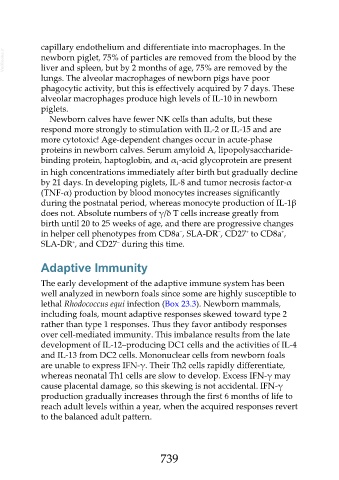Page 739 - Veterinary Immunology, 10th Edition
P. 739
capillary endothelium and differentiate into macrophages. In the
VetBooks.ir newborn piglet, 75% of particles are removed from the blood by the
liver and spleen, but by 2 months of age, 75% are removed by the
lungs. The alveolar macrophages of newborn pigs have poor
phagocytic activity, but this is effectively acquired by 7 days. These
alveolar macrophages produce high levels of IL-10 in newborn
piglets.
Newborn calves have fewer NK cells than adults, but these
respond more strongly to stimulation with IL-2 or IL-15 and are
more cytotoxic! Age-dependent changes occur in acute-phase
proteins in newborn calves. Serum amyloid A, lipopolysaccharide-
binding protein, haptoglobin, and α -acid glycoprotein are present
1
in high concentrations immediately after birth but gradually decline
by 21 days. In developing piglets, IL-8 and tumor necrosis factor-α
(TNF-α) production by blood monocytes increases significantly
during the postnatal period, whereas monocyte production of IL-1β
does not. Absolute numbers of γ/δ T cells increase greatly from
birth until 20 to 25 weeks of age, and there are progressive changes
+
−
−
+
in helper cell phenotypes from CD8a , SLA-DR , CD27 to CD8a ,
−
+
SLA-DR , and CD27 during this time.
Adaptive Immunity
The early development of the adaptive immune system has been
well analyzed in newborn foals since some are highly susceptible to
lethal Rhodococcus equi infection (Box 23.3). Newborn mammals,
including foals, mount adaptive responses skewed toward type 2
rather than type 1 responses. Thus they favor antibody responses
over cell-mediated immunity. This imbalance results from the late
development of IL-12–producing DC1 cells and the activities of IL-4
and IL-13 from DC2 cells. Mononuclear cells from newborn foals
are unable to express IFN-γ. Their Th2 cells rapidly differentiate,
whereas neonatal Th1 cells are slow to develop. Excess IFN-γ may
cause placental damage, so this skewing is not accidental. IFN-γ
production gradually increases through the first 6 months of life to
reach adult levels within a year, when the acquired responses revert
to the balanced adult pattern.
739

